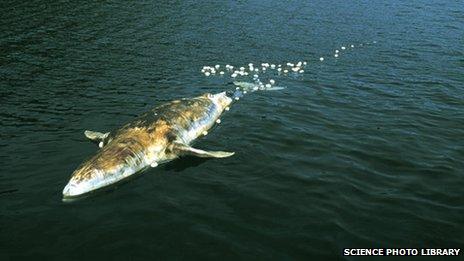How to rescue whales tangled in nets
- Published
The Campobello Island Whales Rescue team at work
The Campobello Island Whale Rescue team disentangles whales caught in fishermen's gear and nets around the Bay of Fundy off the east coast of Canada.
To free a trapped whale, you have to tire it out. When writhing around in the water, they can be impossible to cut loose, so volunteer Mackie Greene ties polyurethane balloons to the fishing nets wrapped around their fins.
These make it harder for the giant mammals to dive back beneath the surface, and allow his team to start severing the ropes.
In the early 1990s, Greene had wanted to become a fisherman, but years of overfishing in the Bay of Fundy had left cod stocks heavily depleted.
"I still wanted to be on the water though," he says, "so I started a little whale watching business back in 1995."
The bay is a rich feeding ground for a variety of sea life, attracted to the coast in search of food. The densely populated waters are a similar draw for fishermen, whose nets can prove fatal for the whales.
Greene got to know a team of marine scientists stationed in the bay, and when a whale became wrapped up in a fishing net he helped them untangle the cords and set it free. "I helped them out and I fell in love with it," he says.
The activity can be a perilous task. Without specialist knowledge, it is easy for the animals to become tangled further still, sometimes suffocating in the process.
"A lot of people think it sounds simple - 'I'd like to take a run out and untangle a whale' - but if you don't have the right equipment you can do more harm than good."
A common mistake is to cut the buoy ropes which the nets get caught in, but they are essential for holding the whale in place. Attaching more balloons causes more discomfort for the whale, but helps steady it in the water and affords the rescuers greater freedom to work.

A dead grey whale caught in a fishing net
Humpbacks are the easiest to work with, says Greene. "Some of the whales understand what's happening. Humpbacks are more sociable, and more used to people, so they're not as afraid."
"But we get the exact opposite too. North Atlantic right whales can fight you right the way to the end. They're big, strong, animals and they move about the whole time. They're more aggressive."
Six people on Campobello Island, where the rescue service is based, are trained volunteers. "Most are ex-fisherman, and one is a scientific advisor from the research centre," he explains.
When a call comes in, they assemble whoever is available. "It's like a volunteer fire department, so we take who we can."
The team now recognise many of the whales on sight, and have named those they know best. A minke whale whose dorsal fin has been cut clean off is called Slice, and an old finback who appears to be a social outcast - always swimming behind the main group - is called Grumpy Gus.
Green says it is the animals' intelligence he is attracted to.
"I've been doing this for 19 years and they're very hard to figure out. One of the hardest things is that we only see them for such a short period of their lives when they come up to take a breath. What do they do for the rest of the time? Sometimes I think they're down there laughing at us."
Besides his affinity with the animals, Greene says there is an element of reciprocation in his decision. Because he makes his living by taking tourists on whale watching tours around the bay, he feels he owes them something in return.
He is a self-confessed adrenaline junkie too, for whom the excitement of rescue is its own reward.
"It's such a great feeling and you're sailing back across the bay after a successful disentanglement," he says. "It feels like you could jump over the moon."
There are more volunteering stories in the BBC News series Making Time
You can follow the Magazine on Twitter, external and on Facebook, external